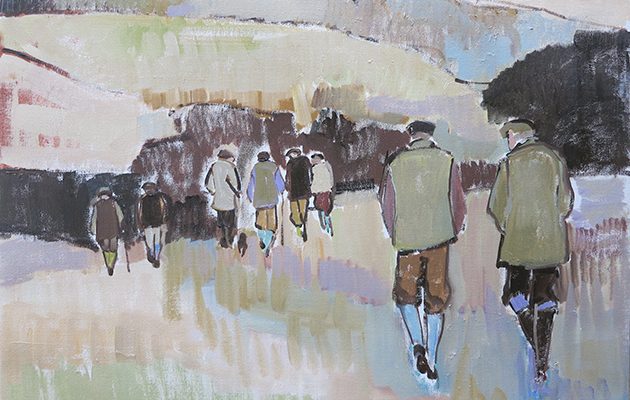Bridget Lansley explains to Janet Menzies why she has put the people back into paintings of shoot days
Despite the importance of people to a shoot day, the guns, beaters and pickers-up are rarely featured in our sporting art. Bridget Lansley tells Janet Menzies why she is putting people back into her shoot day paintings.
For more sporting artists, the greats would approve of Sophie Harden, who is inspired by her days out with the Pytchley. And the sculptures by Tom Hill are made by sport, for sport.
BRIDGET LANSLEY
Traditional sporting art, hanging little noticed on the wall as you eat your shoot lunch, relies heavily on depicting the quarry. Grouse burst out of the canvas towards an unseen gun in his butt. Partridges nestle under a hedgerow. Pheasants wing their way up into a frosted blue sky. Given that there are at least a dozen friends sitting round the table with me, and another 20 or so eating pasties in the beaters’ room, it leads me to wonder where the people are in these paintings?

Going to the Third.
They are in Bridget Lansley’s paintings, that’s where. Lansley’s 21st-century shooting paintings actually depict a shooting day rather than what people are shooting at. The only birds you see are dangling from the hand of a picker-up. Instead, there is a flood of recognition as you look at the backs of two guns walking ahead of you to the next drive, deep in conversation and shoulder-to-shoulder. Beyond is the hill, vibrating in colour that is really, surprisingly, there when you raise your eyes.
Lansley explains how this came about: “For my partner’s birthday I copied a photograph that I had taken in the shooting field – I don’t normally copy photographs but this was him and his son and so I did the painting and he loved it, and he said do some more. I did another one and took it to the framer and a woman walked in and bought it straight away to give to her husband. So that’s how it started. Since then I have sold masses – they just go. I think what people in the shooting world like is that they can relate to these paintings. They love that it is from behind, which is how you always are on a shoot day. And then you get the landscape and the terrain beyond and people really identify with it.”

Bridget Lansley. Queue Here.
Her pastel colour palette is equally important. “I carry the images in my head and when I start a shooting painting I think of the shape of the people and the composition, and gradually it evolves. But the harmony of the colour is most important: if that goes wrong the whole thing is awful. When I started I was not really conscious of deliberately taking a different point of view but I love landscapes and then I wanted to put people in the landscape.”
THE HEYDAY OF SHOOTING AND HUNTING
The Victorians and Edwardians in the heyday of shooting and hunting weren’t interested in people at all. Instead, they had an almost psychopathic obsession with numbers – how many brace in the bag; how many miles in the ‘point’ of the fox’s run – that contributed much to the public antipathy towards these sports in the next generation. This is reflected in their art, with notorious paintings such as The Monarch of the Glen showing a stag and, for today’s eyes, an unseen and unspoken backdrop of the humans displaced in favour of red deer. Lansley’s empathetic work puts people right back in the foreground of sport, depicting the whole experience of a shooting day: the camaraderie, the beauty of the scenery, the connection between humans and their environment. She has a modern sensibility that is true to shooting as we experience it today. Her titles complete the story told by each painting: Across the Moors; Turn for Home; Following the Gun Cart. “The titles are important to me,” explains Lansley. “I feel it brings the painting to life and it helps people relate to the work, so it’s part of the painting.”
Now Lansley plans to take her work beyond the shoot and inside to the dining table. “A friend commissioned me to do a dining scene and I found this really interesting so I am thinking of doing more of these. The dining table is a wonderful opportunity to observe people interacting with each other – across that space that is the table.”

The Start of the Season.
Investigating space is important to Lansley’s work. She trained as a still-life painter with Robin Child. “We painted bottles and chairs, and you are told to look at the spaces in between. As an artist that is what I do, and more than that I am interested in the spaces in between in life.”
So it is no coincidence that much of her work captures ‘in-between’ moments: walking between drives; watching a dog on a retrieve; waiting for the start of the next race. These are not the grand scenes of pheasant flushes and winning posts, but a much more intimate narrative of our sporting life. This must surely be the right story to tell people about country sports today.
Bridget Lansley will be holding a solo exhibition later this year at Cricket Fine Art of Chelsea and Hungerford, visit: www.cricketfineart.co.uk. Her work is widely available in galleries and through her website: www.bridgetlansley.com





